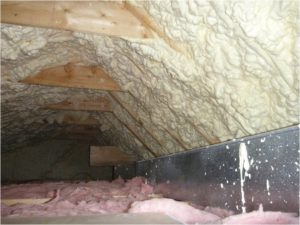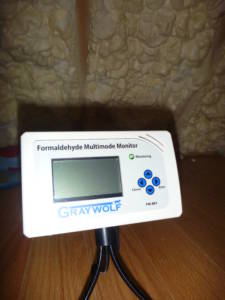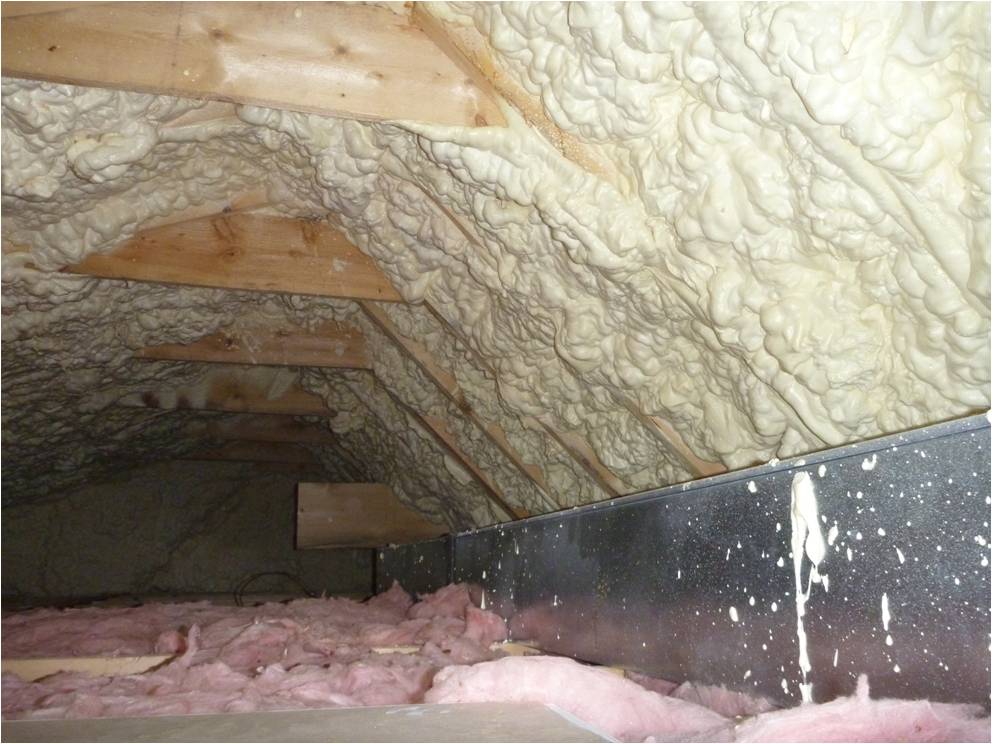Toxic spray foam insulation is the worst mistake you can make as a homeowner. Choosing the right insulation for your home is serious business. You expect it to seal your home and help you lower your energy bill, but sometimes, saving money comes at a hidden cost you might not be willing to pay.
Spray foam insulation has been a top choice among builders and homeowners in recents for many reasons. Its biggest benefit is that it completely seals all the tiny cracks and holes that let bugs, air, and moisture creep into your home.
At face value, spray foam seems like a clear winner. But what the insulation company might not tell you is that spray foam can lead to a toxic home environment. Whatever you save on your energy bill as a result of spray foam could potentially be at your health’s expense.
Let’s explore what spray foam insulation is and the potential dangers it can cause so you can make an informed decision for your home and health.

What Is Spray Foam Insulation?
Spray foam insulation is typically made of polyurethane and isocyanate that is applied to surfaces requiring insulation. The foam begins as two sets of separate liquid and is sprayed as one to create the insulation. The liquid is applied directly onto the surface in a thin layer and quickly expands into foam to fill large areas and create tight seals.
Spray foam typically comes in three different varieties: high density, medium density, and low density. Each type has its specific use cases, with high density being used in high-performing applications like roofing and exteriors and low density being used primarily for interior walls.
There are two main types of spray foam insulation: open cell and closed cell. The open cell type is more dense than closed cell and feels sponge-like to the touch. It’s a great choice for noise reduction and is generally less expensive than closed cell insulation. Closed cell insulation excels at keeping out moisture, reducing energy costs, and serving as an eco-friendly insulation option.
Poor Indoor Air Quality Causes Headaches
The Dangers of Using Spray Foam Insulation
On the surface, spray foam insulation’s popularity seems warranted. It’s been proven to reduce energy costs for homeowners. It seemingly lasts forever. It creates an airtight home that keeps out pesky bugs and damaging moisture. It’s been touted as “generally” safe for homeowners, provided the foam has had enough time to fully cure.
But some of its supposed benefits can also be considered its weakest links.
Exposure to Toxic Chemicals
Knowing how spray foam insulation is applied can help you to be aware of the effects it may later have on your health.
Generally, spray foam insulation installation is a process completed by professionals with the right tools, training, and equipment. The chemicals using in spray foam can be immediately hazardous to a person’s health if not properly handled.
Workers must use the right protective gear to shield their eyes, nose, and throat from the damaging VOCs in the isocyanate. They avoid all skin contact with the chemicals. Residents are required to leave the home for at least 24 hours after the insulation has been applied.
In short, this stuff is seriously harmful if not handled properly.
What’s worse is that improper application of the spray foam could have lingering consequences on your health. If you become exposed to the harmful chemicals in spray foam before it has a chance to fully cure, you could risk developing asthma or other breathing problems, along with eye and skin irritation.
If the foam were to crack or break due to poor installation, you could also be subjected to foul odors.
The Downsides of an Airtight Home
Having a perfectly sealed home sounds like a homeowner’s dream, but it has its share of disadvantages.
For starters, airtightness means that any moisture that becomes trapped within the home has nowhere to go. Without a proper ventilation system, moisture can cause excess damage to your home that will negate any savings you’ve incurred from using spray foam.
It can also cause the quality of your indoor air to plummet if you don’t have other systems in place to improve it. Low indoor air quality can be associated with numerous health issues, including dry skin, stuffiness, and allergies, to name a few.
Suffering From Brain Fog
Spray Foam Is Permanent
The good news is that spray foam is a permanent insulation solution. The bad news is that spray foam is a permanent insulation solution. In this case, permanency cuts both ways. You’ll be glad knowing your investment will carry you years into the future and continue to deliver cost-saving benefits. But, spray foam is almost impossible to get rid of, even if it’s found to be defective. If your foam isn’t properly cured or begins to crack due to improper installation, you’ll likely have to live with its effects for a long time. Your home may become uninhabitable if the negative effects are severe enough.
Bottom Line: Should You Use Spray Foam Insulation in Your Home?
Improper installation isn’t a common occurrence, but you should realize that it does happen. And when it happens, it can pose a far greater risk than any benefits spray foam offers. If you want to maintain a healthy home, you might want to consider other insulation options that don’t carry as great a risk as spray foam.
If you choose spray foam insulation for your home, make sure it’s installed by a professional who guarantees a safe application. You should also ensure you have a proper energy recovery ventilation system (ERV) that allows for adequate airflow to mitigate some of the damaging side effects of spray foam.
Our team specializes in testing and assessing homes for toxic mold and chemicals to ensure these silent killers are discovered and eliminated before they can deal major damage. Talk to us today for a free quote on having your home tested and enjoy peace of mind for every moment you spend at home. Ask For the IndoorDoctor Spray Foam Testing Plan.







